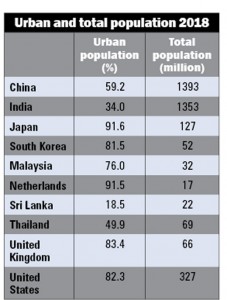Rural-uprooting and urban-replanting
View(s):In 2014, China unveiled a strange urbanisation plan – the National New-type Urbanisation Plan (NUP)–, to accommodate 100 million people in the cities by 2020, and 250 million people by 2026. Where would people in 100s of millions come from in order to dwell in the cities? They would have to come from the remote rural areas in China.
This means that it was, apparently, a genius plan for relocating people – in fact, the farmers, from rural areas to urban cities. “What a peculiar plan is that?” I am sure, many of us, including many scholars and intellects, might ask that question. They might find many issues of “dislocation” rather than “relocation” to be discussed from many different points view.
No small deal
Relocating 100 million people in six years! It’s not a “small deal” even for the Chinese government. The number of people that the plan was talking about is nearly five times bigger than the entire population of Sri Lanka. And thereafter, China wanted to increase even that number of people to be relocated to 250 million.
In order to implement the plan, the Chinese government initiated expanding its “megacities”. By definition, megacities are the metropolitan areas which can accommodate more than 10 million people, which is about half of the Sri Lankan population. China already has 15 such cities which would be expanded further to become “super” megacities.
Out of its 1.3 billion population in China, more than 50 per cent are already living in the urban areas. And the Chinese urban plan was to increase it further, and in fact, it did during the past five years. Why? China has done a comparison of its urban-rural population ratio: In developed countries, on average about 80 per cent of people live in the urban sector. Much more than that, even in the developing countries with similar per capita income levels as in China, urban population accounts for about 60 per cent of the total. Thus, China wants to increase its urban population share, which now looks awkward.
China has a point: it cannot be a “developed country” by preserving its “underdeveloped” characteristics. These characteristics would even become obstacles to China’s ambitious development prospects. The inverse is also true: A change in a country’s “underdeveloped characteristics” can actually, speed up its development process too.
Politically correct, but…
I thought of quoting from the above genius plan today, because its central issue is not deviating from what we have been discussing over the past few weeks: For Sri Lanka to become rich country, or to be more specific, to become a “high-income” country with over US$ 12,000 per capita income, it is necessary to allow relocating about 1.5 million people from rural agriculture to industry and service sectors.
It is not a politically “correct” statement, especially during election times. All of the politically correct policies and actions in the past – protection, subsidies, guaranteed prices, fertilizer, written-off loans, and all of which are yet to come to pass after this election times too, ultimately lead to “nail down the rural farmers” to the same status where they already were. These measures have, indeed, helped them to survive; but they prevented the people from thriving.
And most of these farmers in rural agriculture have selected it to be their occupation, not because they liked it, but because they didn’t have a choice. Simply, they were thrown into a less-rewarding rural agriculture, and helped them to survive there with government support, which looked as if it is a big incentive to remain poor.

Chinese farmer
Thrown into agriculture
Chanuka Wattegama,a researcher and academic, shared with me some interesting results of one of his joint researches carried out in Mahavilachchiya, where a project was implemented in 2007 to introduce Internet facilities. Out of the 96 school children included in the survey, there were 46 from the beneficiary families of the project, and 50 students from non-beneficiary families outside the project area.
In responding to a question on their job aspirations, none of the students from both beneficiary and non-beneficiary groups indicated agriculture as an area for their aspirations. This result is stunning; it clearly shows that it was not the rural people’s choice to be in agriculture. In fact, they have been thrown into rural agriculture, and thereafter they got trapped in it.
As it was clearly visible, the differences in job aspirations between the two groups appeared to depend on their education and exposure. From the beneficiary group, the highest number of students (54 per cent) liked IT-related job. From the non-beneficiary group, the highest number of students (34 per cent) liked to be in armed forces. Almost an equal number of students around 20 per cent from each group selected teaching as there preferred job.
In fact, whenever people find opportunities outside agriculture, they are ready to leave it. This is why, when the children of the farmer families receive education, they have job aspirations outside agriculture, and they are willing to take it up.
What is wrong there?
When countries begin to march towards development benefiting from “high-income” status, apparently the urban-rural population composition should change. Population concentration in the cities is not only an outcome of development, but also a source of development.
All developed countries exhibit a greater share of population concentrated in the urban sector, leaving a fewer number of people in the rural areas.
Increased urban population provides the necessary human resources for the fast-expanding industry and service sectors. At the same time, with the remaining small number of people, rural agriculture becomes more productive and competitive.
But Sri Lanka presents a peculiar slow change in urban-rural population composition; according to official statistics, we have only 18.5 per cent of population in the cities. It shows that our industry and service sector growth has not been satisfactory, and nor has the rural agriculture sector become productive and competitive.
Chinese strategy

Source: World Bank data
The underlying factors of the China’s genius urbanisation plan is interesting to note: Although China has been growing fast and became the world’s second largest economy, its densely populated vast rural sector is still poor. In fact, China also has too many people per small-scale less-productive farms – the average farm size is only about 1 hectare.
Rural development, on the other hand, is far more expensive for the government to provide all the necessary facilities. And the long-term economic benefit of relocating part of the rural people in the urban sector is beneficial for the people themselves as well as for the national development.
Relocated people will provide the necessary human resources for the expanding industry and service sectors. The urban areas were experiencing labour shortages, causing higher wage bills. Furthermore, China also has to build up its domestic demand to sustain higher growth. The new arrivals to the cities, and their next generation will change their life styles, expanding aggregate demand. This will sustain further expansion in the Chinese economy with higher growth rates in the years to come.
And less-populated hinterland in the rural areas is also good for increased forest cover and to protect environment. Although China has a well-known poor track record for having polluted cities, it is also changing rapidly.
While China is preparing to sustain its gigantic economic expansion with both its domestic and global programmes, some other countries in Asia are trying to figure out what else can be offered to rural farmers in order to keep them locked in the same rural sector for another generation.
(The writer is a Professor of Economics at the University of Colombo and can be reached at sirimal@econ.cmb.ac.lk).


